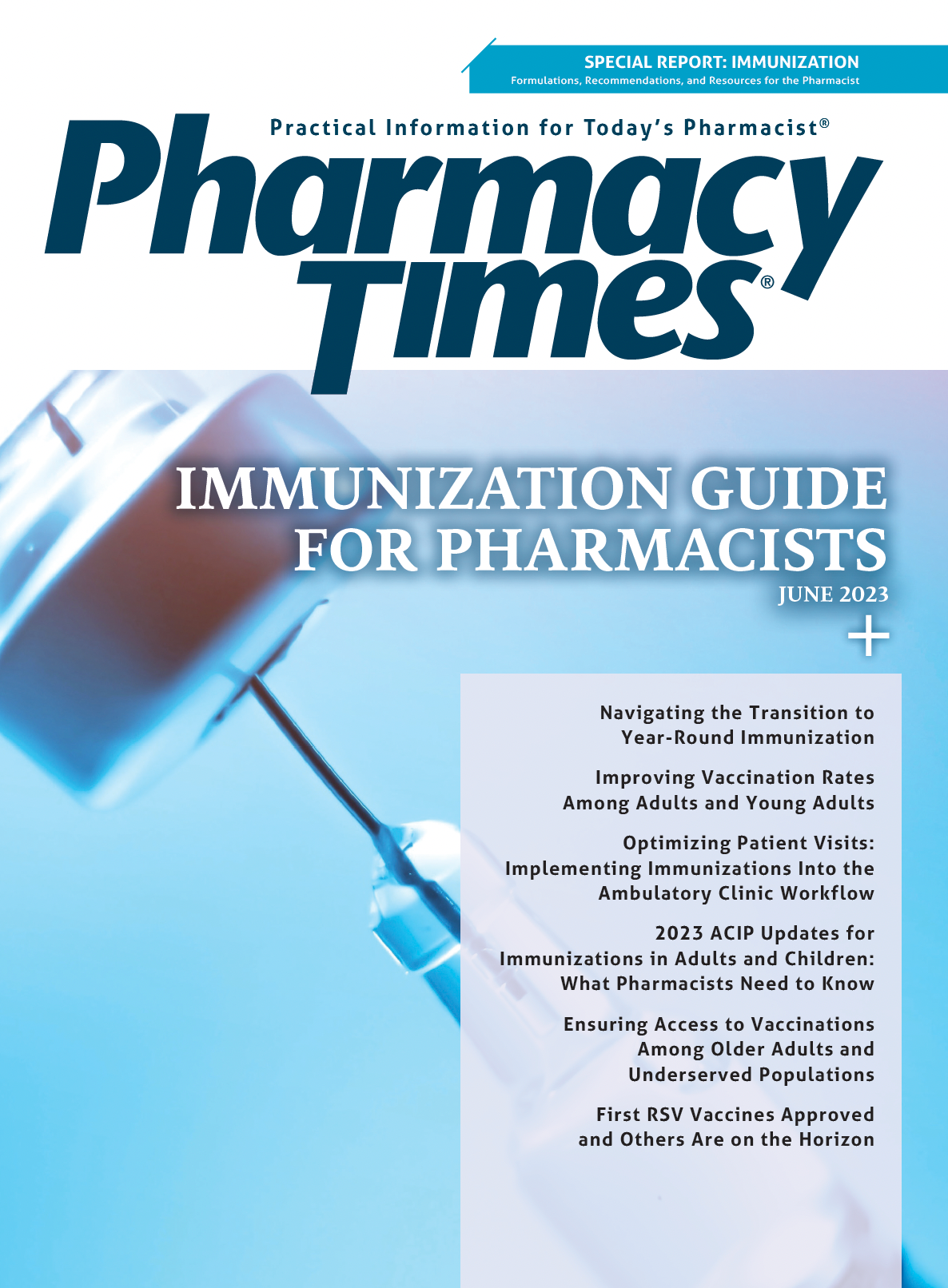Publication
Article
Supplements
You Mean We Should Do This Year-Round?
Navigating the Transition to Year-Round Immunization
COVID-19 Boosters Become Trojan Horse for Perennial Focus Immunizations
Trsakaoe - stock.adobe.com

Although there has been some expected seasonality with COVID-19, the sequencing of primary vaccination with boosters and a layering of when and who are recommended to receive the vaccination have extended the typical range of months that pharmacies focus on immunizations.1 Whereas manufacturers, communicable diseases experts, and health care providers expect an increase in risk of patients contracting COVID-19 in the fall, we are still in the early phases of the endemic and additional strains are emerging around the world. This may cause adjustments to recommendations, despite the CDC having reported that deaths,hospitalizations, and case rates are now at an all-time low with community immunity in place and summer on the way.2,3
Pharmacies Get More Sophisticated About Year-Round Recommendations
Whether due to the current “extended” seasonality of COVID-19 or a change in posture of pharmacy managers who are looking at the positive effects of immunizations to their bottom lines, pharmacies are generally starting to move to a year-round focus on immunization counseling. Following the Advisory Committee on Immunization Practices (ACIP) guidelines, pharmacists are recommending vaccines year-round when patients are due for them, regardless of whether it is “flu season.” One thing that enables this update is technology. Post COVID-19, more pharmacies than ever have connections to vaccine registries, which allow them to run algorithms for vaccination opportunities and checks against patient prescriptions, medical history, and demographics in real time; in fact, this practice is becoming the norm. These new systems alert pharmacy staff to check registries and consult the ACIP guidelines, greatly enhancing noninfluenza vaccine uptake within community pharmacies. Alert systems also prompt the prescription-fill workflow or stop it altogether, depending on the circumstances.
Immunization Season Yields to Load Balancing With Year-Round Efforts
For the past few decades, pharmacies “geared up” for immunization season, kicking it off by ordering vaccines in the late spring or early summer for the fall rush and scheduling extra hours for otherwise part-time staff or discouraging vacation time from early October through the end of the year, which is the peak administration time for influenza vaccination. However, as more pharmacies focus on optimizing immunization opportunities year-round,4,5 they’ve shifted to load balancing. Better standard operating procedures and training allow a staff member to momentarily step away from the dispensing workflow and provide a customer with an immunization when the opportunity arises. Additionally, COVID-19 engendered the widespread practice of scheduling patients for appointments; pharmacies now direct patients to come in at certain times and days of the week to ensure staff are ready and customers have little to no wait time.
The Prep Act Gives, But Will it Taketh Away? Not Likely.
The Public Readiness and Emergency Preparedness (PREP) Act provisions were extended through 2024. It would seem that we are in a constant loop of possibly losing COVID-19 pandemic privileges (eg, ordering of tests, vaccinations, and delegation of immunization administration to other staff members), followed by pushback from health officials and providers, and ultimately, receiving an extension (much like requirements for the REAL ID, which were originally set in motion in 2005 but have been extended repeatedly, most recently to 2025).6-8 The reality is, if the public benefits greatly from the provisions both in public health and convenience terms, states will fill the regulatory gap or the federal government will continue to allow community pharmacies to safely and effectively order and administer vaccines. Community pharmacies are ripe for helping to reach population-level immunization goals. Le et al reviewed hundreds of studies, many that were randomized, and reported that pharmacists substantially and significantly increase the likelihood of vaccination (≈ 15%-50%) compared with usual health care avenues without pharmacist involvement.9 The effect is especially pronounced for patients at the margins of motivation, as pharmacists encourage these individuals to complete their recommended vaccinations. It is in everyone’s best interest not to impede the implementation of broad immunization strategies in the pharmacy setting.
The Inflation Reduction Act Provided Another Reason to Consider Year-Rounc Immunization Foci by Eliminating Cost Share for Many
The Inflation Reduction Act stipulates that Medicare enrollees receive first-dollar coverage for vaccines in 2023 and gives states the incentive to enable this via Medicaid.10 Co-payments and coinsurance have been identified anecdotally as well as through numerous studies as a barrier to patient uptake of many vaccinations— particularly those that are administered “year-round.”11 All noninfluenza and non–COVID-19 vaccines recommended by the ACIP are covered under this law.10
Sustainable MarginReimbursment for Non–COVID-19 Vaccine Administration Increased Substantially for Medicare and the Trend is Likely to Continue
Reducing cost share to patients increases demand, as do recommendations by health care providers, and those conversations with patients are likely to be more widespread and effective when health care providers are sufficiently reimbursed for administering vaccines. Rates for Medicare vaccine administration under Part B have reached ≈ $30 (depending on geography) and are now set to increase alongside inflation as measured by the Medicare Economic Index.12,13 With public health and patient advocates and a broad base of immunization providers all recommending immunizations, there will be continued support for sufficient reimbursement for immunization administration. This warrants a year-round strategy for pharmacy staff preparedness and for making immunizations an economically sustainable cornerstone of community pharmacy practice.
About The Author
Troy Trygstad, PharmD, PhD, MBA, is vice president of Pharmacy and Provider Partnerships for Community Care of North Carolina, which works collaboratively with more than 2000 medical practices to serve more than 1.6 million Medicaid, Medicare, commercially insured, and uninsured patients. He received his PharmD and MBA degrees from Drake University and a PhD in pharmaceutical outcomes and policy from the University of North Carolina. He also serves on the board of directors for the American Pharmacists Association Foundation and the Pharmacy Quality Alliance.
References
1. Ebinger JE, Lan R, Driver M, et al. Seasonal COVID-19 surge-related hospital volumes and case fatality rates. BMC Infect Dis. 2022;22(1):178. doi:10.1186/s12879-022-07139-2
2. Stay up to date with COVID-19 vaccines. CDC. Updated May 4, 2023. Accessed May 9, 2023. https://www.cdc.gov/coronavirus/2019-ncov/vaccines/stay-up-to-date.html
3. COVID data tracker. CDC. Updated May 11, 2023. Accessed May 15, 2023. https://covid.cdc.gov/covid-data-tracker/#datatracker-home
4. Trends in vaccine administration in the United States. IQVIA. Published January 13, 2023. Accessed May 12, 2023. https://www.iqvia.com/insights/the-iqvia-institute/reports/trends-in-vaccineadministration-in-the-united-states
5. Popovian R, Winegarden W, Rivera E, Gavigan K. Accessibility of adult immunizations in pharmacies compared to physician offices in low-income communities. J Am Pharm Assoc (2003). 2022;62(5):1644-1647. doi:10.1016/j.japh.2022.03.021
6. Fact Sheet: HHS announces intent to amend the declaration under the PREP Act for Medical Countermeasures Against COVID-19. United States Department of Health and Human Services. Reviewed April 14, 2023. Accessed May 9, 2023. https://www.hhs.gov/about/news/2023/04/14/factsheet-hhs-announces-amend-declaration-prep-act-medical-countermeasures-against-covid19.html#:~:text=PREP%20Act%20immunity%20from%20liability%20will%20be%20extended,regardless%20of%20any%20USG%20agreement%20or%20emergency%20declaration
7. Public Readiness and Emergency Preparedness (PREP) Act. Administration for Strategic Preparedness and Response. Accessed May 9, 2023. https://aspr.hhs.gov/legal/PREPact/Pages/default.aspx
8. Ninth Amendment to Declaration Under the Public Readiness and Emergency Preparedness Act for Medical Countermeasures Against COVID-19. Federal Register. Published September 14, 2021. Accessed May 9, 2023. https://www.federalregister.gov/documents/2021/09/14/2021-19790/ninth-amendment-to-declaration-under-the-publicreadiness-and-emergency-preparedness-act-for-medical
9. Le LM, Veettil SK, Donaldson D, et al. The impact of pharmacist involvement on immunization uptake and other outcomes: an updated systematic review and meta-analysis. J Am Pharm Assoc. 2022;62(5):1499-1513.e16. doi:10.1016/j.japh.2022.06.008
10. The Inflation Reduction Act lowers health care costs for millions of Americans. Centers for Medicare & Medicaid Services. Published October 5, 2022. Accessed May 9, 2023. https://www.cms.gov/newsroom/fact-sheets/inflation-reduction-act-lowers-health-carecosts-millions-americans
11. Kolobova I, Nyaku MK, Karakusevic A, Bridge D, Fotheringham I, O’Brien M. Vaccine uptake and barriers to vaccination among at-risk adult populations in the US. Hum Vaccin Immunother. 2022;18(5):2055422. doi:10.1080/21645515.2022.2055422
12. National fee schedule for Medicare Part B vaccine administration. Centers for Medicare & Medicaid Services. Updated April 13, 2023. Accessed May 9, 2023. https://www.cms.gov/files/document/mm12943-national-fee-schedule-medicare-part-b-vaccine-administration.pdf
13. Effect of the Medicare Economic Index (MEI) on the physician update. Centers for Medicare & Medicaid Services. Published August 8, 2006. Accessed May 9, 2023. https://www.cms.gov/newsroom/fact-sheets/effect-medicare-economic-index-mei-physician-update

Newsletter
Stay informed on drug updates, treatment guidelines, and pharmacy practice trends—subscribe to Pharmacy Times for weekly clinical insights.






